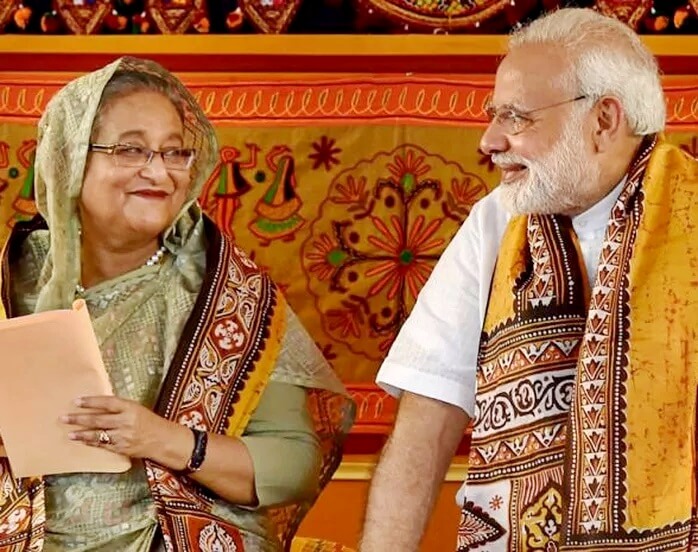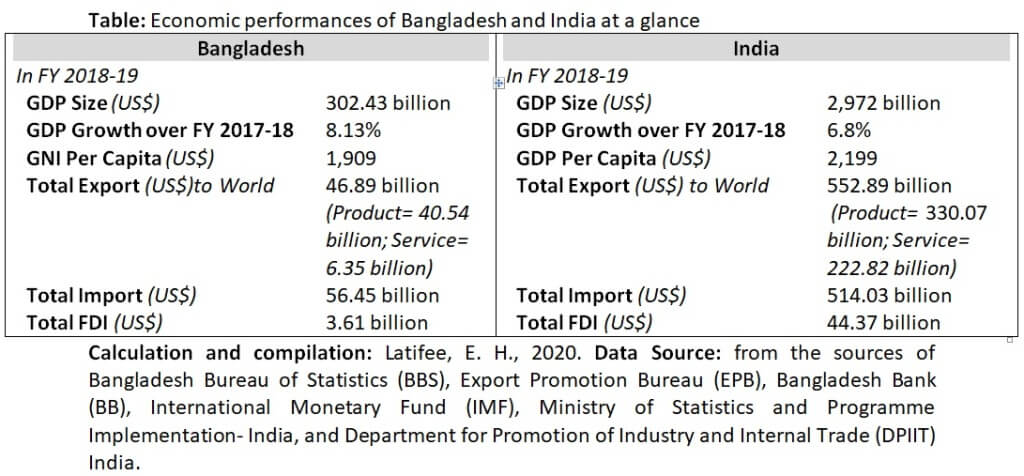
Enamul Hafiz Latifee and Md. Sajib Hossain write,
In December 1971, newly independent Bangladesh required international recognition as a separate state and in this critical aftermath of bloodshed liberation war with Pakistan, India stood first to recognize Bangladesh as a sovereign state establishing diplomatic relations with the country immediately. The fraternity between India and Bangladesh is affixed with secularism, democracy, language, culture, history, shared values and other countless commonalities that traces back unified cultural heritages of a thousand years. Far beyond a strategic partnership, it is based on equality, sovereignty, trust, and mutual understanding. In the last couple of years, the relationship had been further strengthened including cooperation in development activities and newer hi-tech areas.
Since the visit of Honourable Indian Prime Minister Narendra Modi to Bangladesh in 2015 and round back visit of Honourable Bangladeshi Prime Minister Sheikh Hasina to India in 2017, the notable developments that have taken places include resolution of long-pending land and maritime boundaries asserting the issue of enclaves, conclusion of over ninety instruments comprising in the hi-tech areas, i.e., electronics, cyber-security, space, information technology, and civil nuclear energy and observed increase in bilateral trade from US$ 9 billion to US$ 10.46 billion in the Fiscal Year (FY) 2018-19, followed by US$ 7 billion to US$ 9 billion in FY 2017-18, an increase of 28.5 percent.
Rapidly growing India and Bangladesh
India is now the 7th largest and one of the fastest growing economies in the world with a current GDP size of US$ 2,972 billion in FY 2018-19, poised to become US$ 5,000 billion economy by 2025 as envisioned by Indian Prime Minister Narendra Modi that requires securing 9 percent average annual economic growth rate till then.
On the other side, Bangladesh is now considered as an Asian tiger, no longer an aid-dependent country, since it has maintained annual average GDP growth rate of 6.76 percent at the last decade and registered 8.13 percent GDP growth in FY 2018-19 making it to be the 41st largest economy in the world according to the International Monetary Fund (IMF).
Empirical researches show that long-term economic growths of India and Bangladesh effects each other positively following the spillover effects, hence, both countries should elevate the economic fraternity to the next level by reducing the impediments fundamentally that are existing in the avenues of trade, commerce and investment mobility.

Bilateral trade is gaining the momentum
The bilateral trade between India and Bangladesh has witnessed unprecedented heights over the last few years. At the end of FY 2018-19, the bilateral trade of Bangladesh and India has amounted to US$ 10.46 billion for the first time in the history as Bangladesh imported US$ 9.21 billion worth of 2,861 different types of products from India at HS Code 6 Digit Level, according to Department of Commerce, Ministry of Commerce and Industry, Government of India. The top 10 imported items from India during the tenure were- Raw Cotton, Petroleum Oils and Bituminous Minerals, Electrical Energy, Yarn, Motor Cycle and its Engines, Semi and Wholly Milled Rice, Vehicles and its Engines, Chassis, Fresh and Chilled Onions, etc.
Meanwhile, during the FY 2018-19, Bangladesh earned US$ 1.25 billion exporting 568 items to India at HS (Harmonized System) Code 6 Digit Level, according to Export Promotion Bureau of Bangladesh. The top 10 products exported to India were: Men’s Cotton Trousers, Shirts, Vegetable Fats and Fractions, Unbleached Woven Fabrics of Jute, Soya-bean Oil, Women’s Cotton Trousers, Palm Oil, Knitted T-Shirts, Single Yarn of Jute, Rags and Ropes etc. wroth of US$ 0.54 billion which is around 43.41 percent of the entire export earnings of Bangladesh from India.
To keep up this pace, it has to be realized first that Bangladesh and India both have big domestic markets for agro and consumer goods as the population size of Bangladesh is 167 million and India is 1366.4 million, in combined these two countries are places for twenty percent of the world population. Secondly, as the Indo-Bangla traders understand it well, likewise the policymakers of both countries should apprehend that sourcing intermediary manufactured products from competitive neighboring country always means costs-cut in the transportations and logistics that result from importing those items from faraway sources.
Improving the land-ports and establishing single-point customs inspection
Equipping the land –ports with sufficient infrastructural facility is of paramount importance to expand the bilateral trade between India and Bangladesh. Currently, according to Bangladesh Land Port Authority (BLPA), so far 23 Land Customs Stations have been declared as Land-ports.
For the smooth flow of export-import activities and boosting bilateral trade in a cost effective manner, there is an urgency of speeding up the sufficient infrastructural development jointly by India and Bangladesh both in the existing ports or proposed ports such as building required number of warehouses, transshipment yards and shades, keeping standby power generators, installing CCTV surveillance for security aspect and wireless high-speed internet zone for automating the total customs procedure, ensuring sufficient lighting, water supply and proper sewerage systems, resting and food-taking places for the vehicle drivers.
Most importantly, India and Bangladesh should establish single point of customs inspection and clearance system at every land-port rather than practicing existing two-point inspection system separately in India and Bangladesh which is just redundant of the same process thus heavily time consuming. Certainly, this will decrease the time by half accelerating the movement of trucks loaded with the consignments.
Manifesting the Regional Value Chain
Due to the new trade equation of the United States of America with China and India, and frequently fluctuating diplomatic relationship between India and China, it is more pertinent for India to manifest the Regional Value Chain (RVC) for sustaining the economic growth.
India could easily enter into RVC and lead the process that will create the production and work-sharing network in ready-made garments, leather goods, light engineering, information technology (IT) and enabled services (ITES) – especially the business process and management outsourcing (BPMO), agro-processing and in many other prospective sectors with Bangladesh, going beyond the arrangement of South Asian Free Trade Area (SAFTA). Following the example of RVC set by India and Bangladesh, this can be replicated reciprocally in partnership with Nepal, Bhutan and Sri Lanka.
However, for building vibrant RVC, at the first hand, India will require remove tariff and non-tariff barriers, speed up the implementation of rules for harmonization of regulations and technical standards by recognizing the existing standards and tests conducted by the equivalent counterparts of Bangladesh, which in turn, could make the trade between these two countries of the region more fluid.
Enhancing trade through border haats
Border haats came into reality following the visit of Bangladeshi Prime Minister Sheikh Hasina to New Delhi, India on 10-13 January 2010 that aimed at promoting wellbeing of the people residing in remote areas across the borders of the two countries. At present, there is a huge demand for Indian products to Bangladeshi consumers including chocolates, sarees, cosmetics, sandals, betel nuts, and baby-foods that are available at a cheaper rate, whilst Bangladeshi vendors sell products like dry fish, sweet water raw fish, plastics and basic garments.
In an attempt to increase bilateral trade, initiative needs to be expedited in both countries by setting up more border haats at potential connecting points and by extending the number of days in a week for arranging haats. As a part of this effort, Bangladesh should warmly welcome the interest of the Union Home Ministry, India on setting up 70 new border haats.
More to that, consumer’s preference survey should be conducted jointly by India and Bangladesh at regular time interval, should disseminate that information to the local micro-entrepreneurs, both parties should pursue “Entrepreneurship Skills” training programs targeting the local villagers especially the women and making them aware of quality improvement of their products.
Certainly, India- Bangladesh synergy will reach a new height with the next visit of PM Sheikh Hasina to India in October 2019, first after the formation of new government under the leadership of PM Modi’s second term in May this year, which would focus to speed up disbursement of Indian lines of credit (LoC), water-sharing of the 54 common rivers and repatriation of Rohingyas. It is expected that both sides would also focus on the issues related to trade and commerce that have been discussed here paving two countries becoming economic powerhouses.
Enamul Hafiz Latifee is Deputy Secretary, Trade Facilitation Department, Dhaka Chamber of Commerce and Industry (DCCI). He can be reached at enamul.hafiz.sust@gmail.com.
Md. Sajib Hossain is Senior Assistant Secretary, Research and Development Cell, Bangladesh Knitwear Manufacturers and Exporters Association (BKMEA). He can be reached at sajibeconbd@gmail.com.
[…] fraternity between India and Bangladesh is affixed with secularism, democracy, language, culture, hi… that traces back unified cultural heritages of a thousand years. Far beyond a strategic […]
[…] PM Mr. Modi had last visited Bangladesh in 2015. Since the visit and round back visit of Honourable Bangladeshi Prime Minister Sheikh Hasina to India in 2017, notable developments have take…. […]